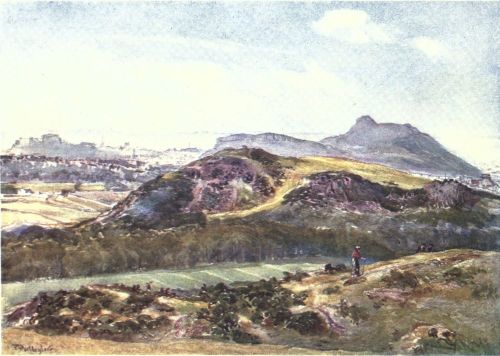Annotation:Arthur's Seat (1): Difference between revisions
No edit summary |
No edit summary |
||
| Line 10: | Line 10: | ||
<div style="text-align: justify; direction: ltr; margin-bottom: 90px; margin-left: 70px; margin-right: 120px;"> | <div style="text-align: justify; direction: ltr; margin-bottom: 90px; margin-left: 70px; margin-right: 120px;"> | ||
<br> | <br> | ||
'''ARTHUR('S) SEAT [1]'''. Scottish, Hornpipe (2/4 time). B Flat Major. Standard tuning (fiddle). AABB (Hardie): AA'BB (Brody). | '''ARTHUR('S) SEAT [1]'''. Scottish, Hornpipe (2/4 time). B Flat Major. Standard tuning (fiddle). AABB (Hardie): AA'BB (Brody). | ||
[[File:ArthursSeat.jpg|500px|thumb|right|Arthur's Seat from the Braid Hills, c. 1904 by John Fulleylove. The Salisbury Crags and “Lion” of Arthur’s Seat are above all.]] | |||
The hornpipe was composed by the famous Scots composer and fiddler [[biography:J. Scott Skinner]], appearing first in his '''Cairngorm Series''' (Pt. 6). Arthur' Seat is a prominent Edinburgh landmark, a high volcanic plug. The name is quite ancient, having been first recorded by Giraldus Cambrensis in the 12th century as ''Cathedra Arturi'' (the Greek word ''cathedra'' means throne), and stems from the time the area was Brittonic, prior to the invasions of the Anglo-Saxon tribes. | |||
<br> | <br> | ||
<br> | <br> | ||
Revision as of 02:32, 15 July 2018
X:1 T:Arthur Seat [1] C:J. Scott Skinner M:4/4 L:1/8 K:Bb f/|b/>f/d/>B/ A/>B/ F/>E/|D/D4/4D/ F/>B/ d/>f/b/>f/|=e/>f/ _e/>f/ d/>f/c/>f/| b/>f/d/>B/ A/>B/ F/>E/|D/D4/4D/ F/>B/ d/>f/b/>f/|=e/>f/g/>f/ _e/>c/A/>f/|B{a}bB:| |:^f/|g/>^f/g/>d/ e/>d/e/>c/|f/>=e/f/>^c/ d/>c/d/>B/|e/>d/e/>=B/ c/>B/c/>_B/|A/>c/f/>=e/ f/>^f/g/>a/| b/>f/d/>B/ A/>B/ F/>E/|D/D4/4D/ F/>B/ d/>f/b/>f/|=e/>f/g/>f/ _e/>c/A/>f/|B{a}bB3:|
ARTHUR('S) SEAT [1]. Scottish, Hornpipe (2/4 time). B Flat Major. Standard tuning (fiddle). AABB (Hardie): AA'BB (Brody).

The hornpipe was composed by the famous Scots composer and fiddler biography:J. Scott Skinner, appearing first in his Cairngorm Series (Pt. 6). Arthur' Seat is a prominent Edinburgh landmark, a high volcanic plug. The name is quite ancient, having been first recorded by Giraldus Cambrensis in the 12th century as Cathedra Arturi (the Greek word cathedra means throne), and stems from the time the area was Brittonic, prior to the invasions of the Anglo-Saxon tribes.
Bill Hardie notes that the cross bowing he indicates in his printed version of the tune "is particularly suited to the chromatic writing in the second strain." Skinner himself made a 78 RPM recording of the tune in the early 1920’s as part of “The Celebrated Hornpipes” medley. See also Irish versions under the title "Fly By Night (1)."
